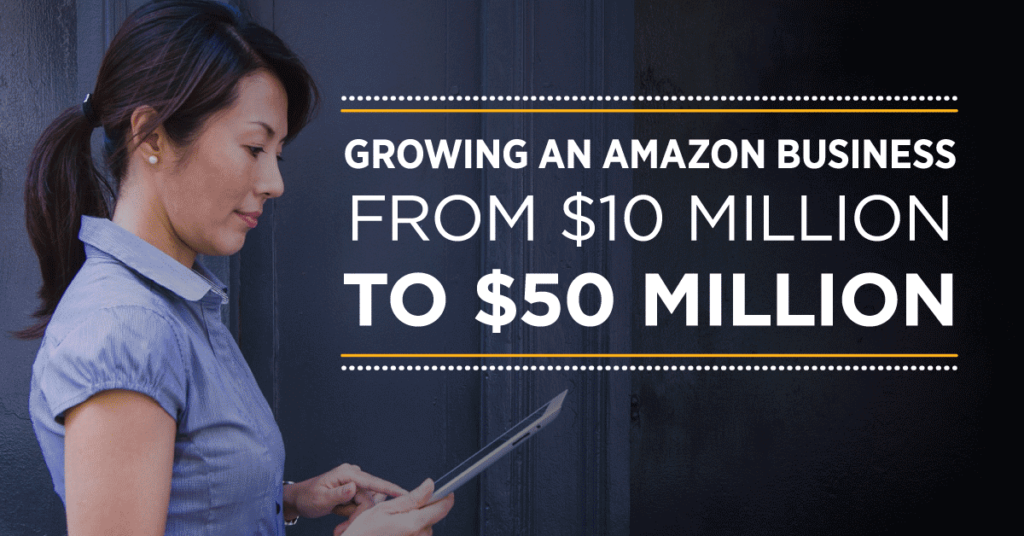I’ve heard business compared to a flywheel. When first starting, you must push as hard as you can to get only a little bit of motion. You’re pushing and pushing and pushing, but your business is only moving marginally faster.
Over time, though, as you crank on the issue and maybe then have some extra hands to help push, it starts to move. Slowly at first, but then it starts to pick up speed. Eventually, it’s taking off on its own and now you move to managing all of the unexpected extra that comes with it.
As a multichannel marketer, you’re constantly thinking of new ways to grow your business. Maybe you started small and scrappy and now you’re reaching maturity and ready to scale your business. So how do you do that?
To get the answers, I reached out to Nathan Grimm, the Director of Marketing and Product at DNA Response, an agency in Seattle dedicated to helping ecommerce companies grow and scale their revenues through distribution.
On to Nathan!
First, can you introduce yourself and give us your definition of multichannel marketing across platforms like Amazon, Ebay, and the like?
I’m the Director of Marketing and Product at DNA Response, Inc. After getting through my inbox in the mornings I increase revenue for a wide range of brands on marketplaces like Amazon. They added “and Product” to my title because I like to tell the technology team what to build next. I have the most fun solving problems and optimizing processes with my team.
Multichannel marketing in eCommerce is the practice of generating awareness and processing orders on multiple platforms. It requires a unified strategy to organize product data, marketing messages, and operations to maximize performance. A typical multichannel eCommerce company will run marketing campaigns on advertising networks, social media, comparison shopping engines, and blogs. They will process orders on their brand’s store, landing pages, Amazon, and other marketplaces.
The term multichannel marketing is often used next to omnichannel marketing. The difference is in how you view the world of commerce. The multichannel marketer sees many different selling opportunities to promote and sell and tries to maximize each opportunity. The omnichannel marketer sees a single target market with multiple ways to communicate and sell to them. They will try to optimize the whole experience to maximize sales, customer experience, and brand value. An omnichannel marketer will also work with multiple selling and advertising platforms but they will be very concerned with consolidating data and gaining a unified view of their customers’ experiences.
Multichannel marketing is a tactical view. Omnichannel marketing is a strategic view.
What’s different about growing a business from $10 million to $50 million in sales as opposed to growing from $1 million to $10 million?
Your business develops layers.
Growing revenue always coincides with growing effort. Your order numbers, customer service calls, SKUs, shipments, and marketing programs often increase as well. While every business is different, companies tend to add layers of management and begin to hire specialists once they move beyond $10 million in sales.
Organizations with $1–10 million in sales are typically staffed by 1–5 people. At that scale, most employees have multiple responsibilities and a broad knowledge of each part of the business. Independence is highly valuable and red tape is nonexistent.
As businesses add the 6–20th employees, the team suddenly has a wide range of expertise. Too much independence can cause inefficiency and disorganization. Documentation, process, reporting, and good management become just as critical to your business as creativity, speed, and a lack of red tape were when the company was smaller.
Larger businesses typically have more potential improvements as well. As total expenses grow, your business can save significant amounts of money through process optimization. Perhaps your storage costs used to be $2,000 per month. Now, they’re $30,000 per month and the effort to optimize your warehousing is worth several months of effort. Because of the great number of opportunities to save money, leadership will constantly discuss prioritization and optimization.
What’s the biggest challenge you see businesses face as they seek to scale their revenues through platforms like Amazon or eBay?
The supply chain is always the biggest challenge. Just as your opportunities increase with size, so do your possibilities for error—and there are innumerable possibilities for error with manufacturing, sourcing, ordering, storing, and fulfilling physical goods.
The most painful thing to see as a marketer is a hot-selling product that has run out of stock, especially if it was an avoidable mistake. Every year, there are a pile of might-haves and should-have-been products that never made a big impact for the business because of supply chain issues.
My blanket advice here is to monitor your supply chain in great detail. You must discover every problem in under a day—even if your partners don’t alert you directly. Then relentlessly remove inefficiency, handoffs, external dependencies, and risk from your supply chain. Don’t add a critical partner to the supply chain without logins and API access to their tools.
If you had your own eCommerce business that reached to $10M in revenue and you wanted to 5x it, what would you do first?
I’d talk to my customers. How could I expect to convince 400,000 people to give me $100 unless I understand their strongest needs and desires? No amount of PPC adjustments, SEO tweaks, and additional channels are going to do it for me. That kind of growth will take a deep understanding of my audience and a great idea.
The second thing I’d do is develop a plan to sustain my advantage with customers. My competitors can copy my marketing messages, keyword targeting, images, and feature list in under 6 months. Sustaining my advantage will require an extra level of control over the market such as patents, distribution agreements, and serious brand equity.
To test the strength of my advantage, I would ask myself this question, “If I sold my business today (without a non-compete agreement), could I rebuild it from scratch in under a year?” My competitors are smart and capable and they’re watching me, so I must build my moat.
What’s the biggest area of opportunity for businesses across the platforms you support?
Develop data analytics and business intelligence capabilities that go beyond canned reports. I recommend this for companies at the $10M stage and looking to grow 5X because you’ve already identified a model that works and needs to grow. Analysis and BI competencies will allow your team to be more disciplined and productive. It will also allow your company to find the inefficiencies and opportunities that naturally occur as you grow.
Amazon and eBay provide some canned reports on historical sales, traffic to your listings, share of buy box, conversion rates, and advertising data. These reports are useful because they come pre-built and on-demand. You can see if sales are going well today, if your PPC campaigns are getting traffic, and if you are winning the buy box for your top product. That’s really good. In addition, there are many tools like Sellbrite, that provide reports on top of what the marketplaces provide that all look at this data in different ways. That’s good too, but you can do more.
Most of the time, the data behind the reports is available to you in raw form as a file export and via API so you can go to work in Excel, Google Sheets, or your in-house database to perform in-depth analyses. Here is an example of how we use the exported data to evaluate PPC profitability.
Purpose: An ideal PPC campaign optimizes for total profits. We also have some campaigns that target a specific cost per order. Amazon’s portal reports only show impressions, clicks, spend, and sales. They don’t include a view of these metrics over time. To effectively optimize our campaigns, we need to measure ROI or CPO for Campaigns, Ad groups, Keywords, and Products over time. Additionally, we want to show clients if their campaign is performing above or below expectations. To do that, we want to show them what percentage of sales they generate from PPC campaigns.
Data Sources (links work if you’re logged in to Seller Central and have proper permissions): Campaign Performance Report, All Orders Report, FBA Fee Preview Report, Internal COGS report.
Tools:
- Seller Central
- Download the Campaign Performance Report
- Internal SQL database
- Order history (also available as the All Orders Report here)
- FBA fees by product (also available as the FBA Fee Preview Report here)
- Internal Cost of Goods Sold data
- Power BI Desktop
- Connect different data sets, define measures, and build graphs
Results:
I can chart your key metrics over time.
I can show clients that their campaign performs very well.
We also use our internal SQL database, Excel, and Power BI Desktop to create client reports, coupon campaign reports, lists of sales gainers and losers, inventory forecasting, Amazon keyword rankings, and more.
What considerations should a company take into account logistically (shipping, payment processing fees, etc.) as they scale?
Spend time analyzing and optimizing your fees. As you grow, there is a huge opportunity to add value here. Develop efficient, automated processes to identify and fix common problems like overstock, understock, and unprofitable products. Then develop automated processes for predicting and preventing those situations. Some examples are:
- Develop sophisticated inventory projection and forecasting models that take into account previous sales, seasonality, advertising budgets, and product category.
- Create easy-to-use margin calculators that use every cost in the supply chain (COGS, storage, shipping, labeling, commissions, fees, and marketing spend). Make those calculators available to your marketing, buying, and supply chain teams so they can make good decisions.
- Have a Plan B for overstocked units. Drop your price to break even, sell through secondary channels, and add buy-back clauses to your purchasing agreements.
It’s important to note that lowest-cost option is not always the highest-value option. You can save money per unit shipping inventory by sea but if you’re out of stock and peak-selling season is right now, put it on an airplane.
What about managing inventory? How will systems need to change as the amount of product moved changes?
The most important decision with logistics is to decide between using a third-party Logistics (3PL) provider and running your own warehouse to fulfill orders to consumers. Consider two things: flexibility and core competencies.
Renting warehouse space, buying equipment, implementing technology and hiring employees gives you a semi-fixed cost structure that changes only in large increments. If your business takes a temporary dip, you won’t be able to shed costs very quickly. If you do, you may not be able to add the same quality resources. 3PLs on the other hand provide a variable cost structure that is usually quite flexible. You pay per cubic foot, by order, and by unit. For a very stable business, you may have some overall savings with a DIY warehouse but in this article, we’re discussing 5X growth. In that case, the variable pricing model of the 3PL wins most of the time.
Do you want to develop warehouse and fulfillment operations as core competencies for your business? If you’re a distribution company and a reseller, maybe; if you’re a brand owner and marketer, probably not.
Many thanks to Nathan for his insights!




